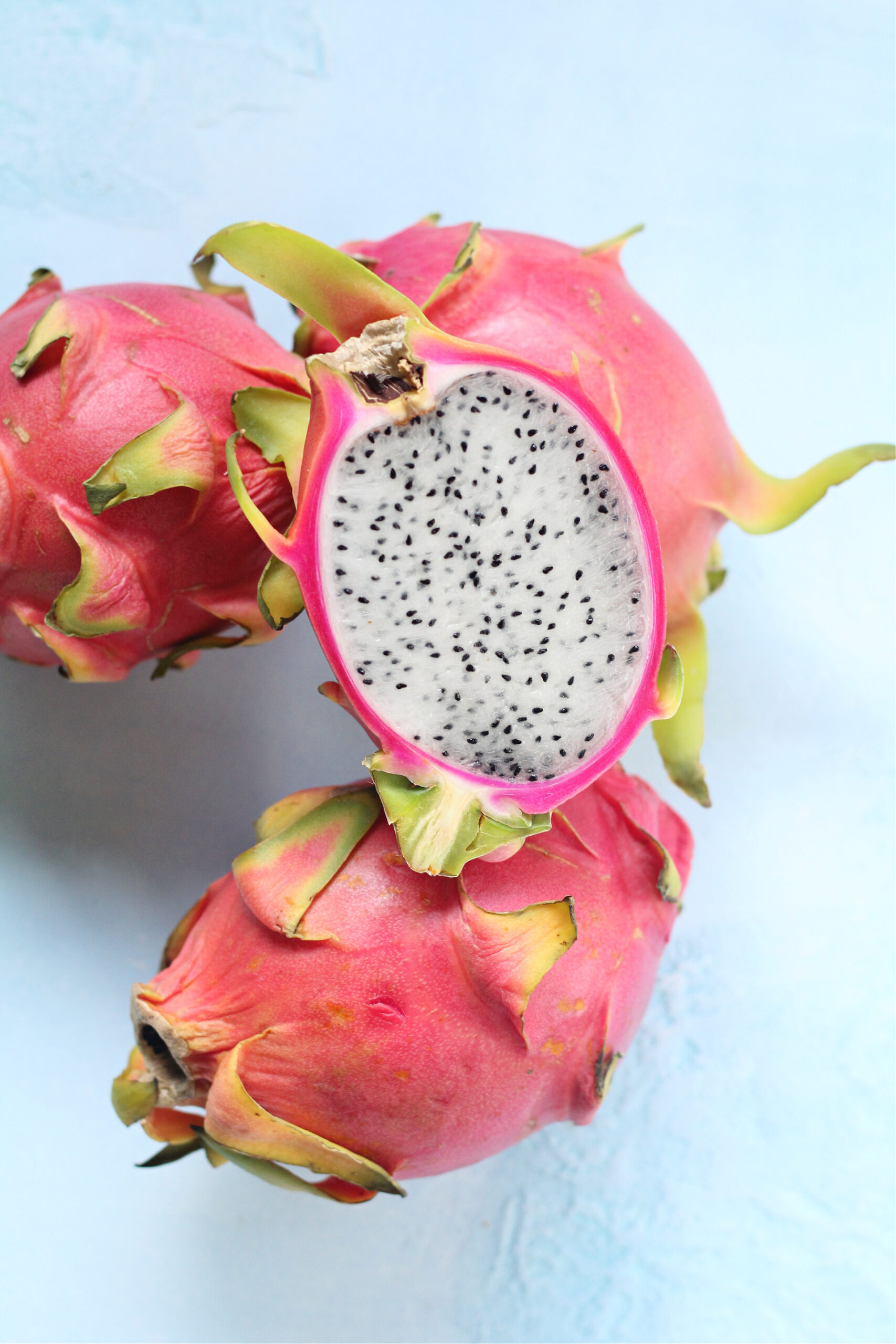This post may contain affiliate links, please read our disclosure policy.
Dragon fruit is not only beautiful, it’s loaded with nutrients and health benefits. Thanks to it’s mild flavor, dragon fruit can be enjoyed in a variety of ways. Learn about dragon fruit and the discover ways to enjoy dragon fruit. While this post is sponsored Noble Citrus, all opinions and my love for produce is my own.
Are you all ready to try something a little exotic? I will admit, this is a new one for me…You typically see me chatting about all my favorite fresh from Florida fruits and vegetables. Well, Dragon Fruit is not from Florida. But it is a beautiful exotic fruit that is loaded with nutrients and is incredibly versatile.
What exactly is Dragon Fruit?
The dragon fruit, also known as pitaya, is a tropical fruit with a story that originates from Central America. While its exact origins are not entirely clear, it is believed to have originated in the region between southern Mexico and Guatemala. From there, the fruit spread throughout the Americas and eventually made its way to other parts of the world.
The dragon fruit is a unique-looking fruit with a vibrant, colorful exterior. It has a thick, scaly, and leathery skin that resembles the scales of a dragon, hence its name. The skin color can vary, ranging from bright pink or yellow to deep red or purple. Inside, the fruit is typically white or red with tiny black seeds scattered throughout.
According to legend, the dragon fruit’s captivating appearance and its association with dragons and mysticism led to various stories and beliefs surrounding its origin. Some tales describe how the fruit grew on the backs of dragons, and warriors would collect the fruit from the dragon’s lair. Others stories tell of ancient kings and queens who treasured the fruit for its exquisite taste and magical properties.
In reality, the dragon fruit is a product of various species of cacti in the genus Hylocereus and Selenicereus. These cacti produce large, night-blooming flowers that are pollinated by bats and moths. After pollination, the flowers develop into the dragon fruit, which takes around 30 to 50 days to ripen.
Dragon fruit gained popularity in Southeast Asia, particularly in countries like Vietnam, Thailand, and the Philippines. In recent years, it has become a trendy fruit worldwide, known for its refreshing taste, nutritional benefits, and eye-catching appearance. The fruit is rich in antioxidants, vitamins, and minerals.
It is used in a variety of dishes and beverages, including smoothies, salads, and desserts.
Are there different types of Dragon Fruit?
YEP! There are three main types of dragon fruit based on their flesh color: white, red, and yellow. Each type of dragon fruit has its own distinct characteristics and flavor profiles.
White Dragon Fruit: This is the most common type of dragon fruit. It has a vibrant pink or yellow exterior with greenish scales. The flesh of white dragon fruit is white, speckled with tiny black seeds. It has a mild, slightly sweet flavor with hints of kiwi and pear. White dragon fruit is often used in smoothies, salads, and desserts. This is the one pictured in this post, it is the one I can find easily in the grocery store.
Red Dragon Fruit: The red dragon fruit, also known as magenta or purple dragon fruit, has a vibrant red or deep magenta exterior with green scales. The flesh of the fruit is either white or deep red, depending on the variety. Red dragon fruit has a slightly sweeter taste compared to the white variety, with a flavor reminiscent of watermelon or a subtle blend of berries. It is often enjoyed fresh or used in various culinary creations. Many smoothie places use the variety with red flesh as it makes smoothies absolutely BEAUTIFUL….that deep color is just stunning in culinary creations.
Yellow Dragon Fruit: The yellow dragon fruit, also known as golden dragon fruit or yellow pitaya, has a bright yellow or golden exterior with green scales. The flesh of the fruit is usually white or pale yellow, dotted with black seeds. Yellow dragon fruit has a sweeter and milder taste compared to the other two types. It has a delicate flavor with hints of honey and citrus. Yellow dragon fruit is commonly eaten fresh or used in smoothies and tropical fruit salads.
What are some of the best ways to eat Dragon Fruit?
Scoop It: The simplest and most common way to enjoy dragon fruit is by eating it fresh and raw. Cut the fruit in half lengthwise and scoop out the flesh with a spoon. You can enjoy it as is or combine it with other fruits to create a colorful fruit salad.
Blend It: Dragon fruit can add a refreshing taste to smoothies and juices. Blend the flesh of the fruit with other fruits such as bananas, berries, or tropical fruits like mango and pineapple. You can also add a splash of coconut water or your favorite juice for added flavor and sweetness.
Freeze It: Dragon fruit can be used to create visually stunning and delicious desserts. You can use the flesh to make dragon fruit sorbet, popsicles, or even blend it into a creamy dragon fruit mousse. It can also be used as a topping for yogurt, ice cream, or chia pudding.
Dragon fruit can be a delightful addition to salads, adding both visual appeal and a unique flavor. Cut the fruit into cubes or slices and toss it into a salad with mixed greens, cucumber, avocado, and a light dressing. The mild sweetness and crunchy texture of dragon fruit complement the savory elements of a salad.
Dragon fruit is also great in cocktails or mocktails. Blend the fruit with ice, lime juice, and your choice of spirits for a refreshing dragon fruit cocktail. For a non-alcoholic version, mix the fruit with sparkling water, lime juice, and a sweetener of your choice.
Remember, dragon fruit’s flavor is relatively mild, so it pairs well with other fruits and ingredients.
What is one of your favorite way to enjoy dragon fruit?
Learn more about Noble Citrus and be sure to follow on Facebook, Instagram and Twitter to stay up to date with all things produce.
Make sure to check out Food Wine Sunshine on Facebook, Twitter, Pinterest, and Instagram for more healthy living tips, healthy recipes, things to do and more.










Comment section